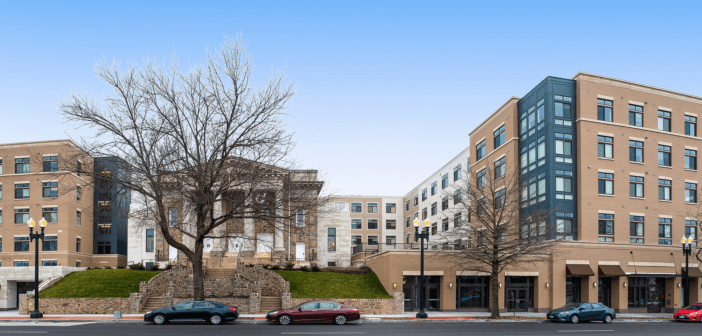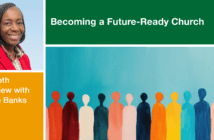Richard Reinhard shares how some congregations are using their property to develop affordable housing and meet other community needs, as well as local initiatives to lower the barriers to this type of development.
Religious institutions face a great mismatch between small, aging congregations and large, deteriorating properties. Thousands are struggling to find new uses for their surplus space in ways that extend their missions and defray operating expenses.
The U.S. is estimated to have a deficit of affordable housing of 500,000 to 700,000 residences. While the amount of money provided by the U.S. Department of Housing and Urban Development and state and local agencies for affordable housing is slowly increasing, the funding is a drop in the bucket compared with demand.
Pairing the surplus of faith properties with the deficit of affordable housing appears to be a match made in heaven. Although America could already boast several successful affordable housing projects in and around former faith properties over the past decades, there’s a renewed interest in church-to-housing among faith communities, municipalities, the real estate industry, and not-for-profits.
Affordable-housing examples
Plenty of good examples exist and are underway of turning faith properties into affordable housing. In a much-cited initiative, The Emory Fellowship, a United Methodist Church in Washington, DC, in partnership with the not-for-profit group Emory Beacon of Light, built the $58 million Beacon Center on church property. The project features 99 units of housing for low-income DC families and permanent supportive housing, underground parking, multipurpose rooms, a gymnasium, office space, community space, and a culinary arts training program.
As part of the more recent wave of redevelopments, Atlanta First United Methodist Church in partnership with Evergreen Real Estate Group of Chicago, has broken ground on a “God-sized” mixed-use development including 320 housing units—85% designated affordable—a new headquarters for the church’s Atlanta First Day School, and 10,000 square feet (929 square meters) of new retail space.
In bold announcements, the presiding bishop of the Church of God in Christ, the largest evangelical, predominantly African American denomination in the U.S., last year announced a partnership with Enterprise Community Partners with the goal of leading to 18,000 new affordable rental and ownership housing units and 72 community facilities. And the bishop of the Episcopal Diocese of Los Angeles last year announced the goal of building affordable housing for low-income families, seniors, refugees, and unhoused people on 25% of the diocese’s 133 church campuses.
Efforts to reduce redevelopment barriers
Localities and even states have begun to organize legislation not only to lower redevelopment barriers but also to assist faith organizations willing to consider affordable housing initiatives. San Diegans have launched a YIGBY (“Yes in God’s Backyard”) movement to provide a counterweight to NIMBY (“Not in My Backyard”) groups. The YIGBY team describes itself as “an action-based, collaborative group of cross-sector professionals called to address San Diego’s housing crisis by activating abundant, under-utilized faith community properties.” The movement is spreading nationwide.
The cities of Atlanta, San Antonio, and Seattle, notable among others, have forged initiatives to encourage faith institutions to consider building affordable housing on their surplus properties. The initiatives can include planning assistance, pre-development money, and density bonuses for affordable housing development. The State of California last year passed SB 4, the Affordable Housing on Faith Lands Act, which makes it legal for faith-based institutions and non-profit colleges to build affordable, multifamily homes on lands they own by streamlining the permitting process and overriding local zoning restrictions.
Other uses
Some faith institutions have reused or redeveloped their properties into uses other than affordable housing while maintaining their need for a religious connection. A site far from mass transit or grocery stores, near natural or human-caused hazards, or surrounded by litigious neighbors can be compelling reasons for a faith institution to opt for a direction other than affordable housing.
The Village at West Jefferson in Louisville is a 30,000 square foot (2,787 square meter) office and retail development at the site of St. Peters United Church of Christ in the primarily African American Russell neighborhood.
St. Jax Centre in Montréal, formerly St. James the Apostle Anglican Church, has been transformed into the home of a not-for-profit circus company, a food mission, a refugee-serving agency, and a homeless-serving agency, in addition to hosting church services.
At a less development-intensive level, St. James United Methodist Church in Brick, New Jersey, is one of dozens across the U.S. that has converted its underused church hall into pickleball courts, providing the church with a new audience as well as additional operating revenues.
In many cases, shrinking houses of worship have reached out to growing religions and denominations, especially those organized by immigrants, to use their facilities, sometimes transferring or selling the properties at below-market value to the new congregations.
Looking ahead
Reuse and redevelopment challenges are extremely different in communities with hot real estate markets and those less robust. Developers in downtown Tampa, Seattle, and Miami recently purchased church properties for $4.8 million, $30 million, and $55 million respectively, to convert into Class A properties. Closed houses of worship in rural communities, small towns, and in the heartland, are likely to remain empty, often deadening the social life and built landscapes in those communities. According to its planning director, Gary, Indiana, a city of 67,000 residents, has more than 250 empty churches.
As excellent as some individual house-of-worship reuse and redevelopment projects have proved to be, the vast number of emptying churches—and the accompanying need for affordable housing—suggest that the public, private, and not-for-profit sectors need to adjust to deliver the breadth and depth of projects that are necessary.
This article is adapted from “Affordable Housing: YIGBY (“Yes In God’s Backyard”) Movement Seeks To Counter NIMBY Movement,” Urban Lands, February 20, 2024. Reprinted with permission of the Urban Land Institute.
Related Resources
- 5 Ways to Overcome Barriers to Affordable Housing Development on Church Property by Rick Reinhard
- 9 Lessons from Nehemiah for Faith-based Property Development by David Bowers
- Negotiating the Coming Wave of Church Property Transitions featuring Mark Elsdon — Watch the Leading Ideas Talks podcast video | Listen to the podcast audio version | Read the in-depth interview
Photo courtesy Residences at the Beacon Center on Facebook






